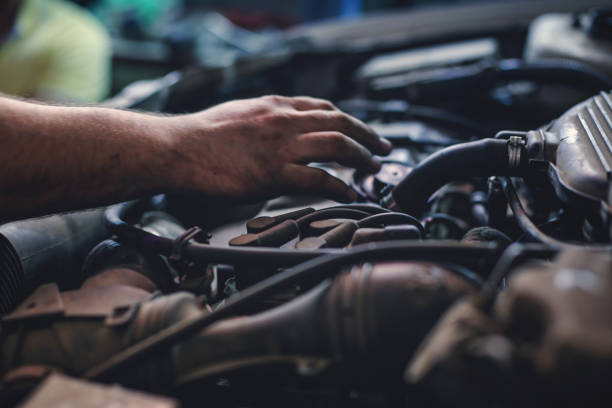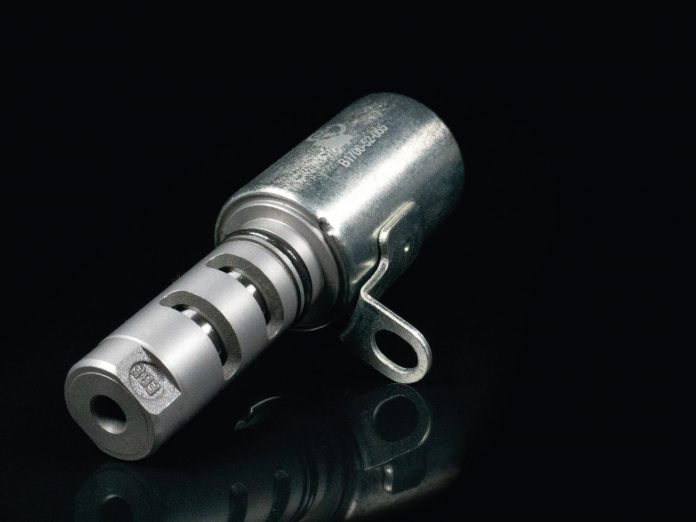Oil control valves are an essential part in an internal combustion engine with variable valve technology (VVT). There are different VVT designs depending on the engine’s make and model. All VVT systems which are controlled by oil pressure have at least one oil control valve.
What does the Oil Control Valve do?
The oil control valve is an actuator (solenoid) which is controlled by the engine’s ECU (Electronic Control Unit) to guide the VVT systems in advancing or retarding the valves’ timing by altering the camshaft angle position in correlation to the engine crankshaft.
Some types of engines only vary the timing of the intake camshaft while other types of engines vary both the intake and the exhaust camshafts. Engines (depending on specifications) can have one oil control valve (e.g. a 4-cylinder engine with VVT in the intake camshaft) to four oil control valves (e.g a V6 or V8 engines with VVT on both camshafts).
Oil control valves are fed by the engines pressurized oil which allows or blocks the oil flowing through them to affect the timing of the camshaft. VVT cams have a control mechanism that change the cam position in relation to the timing chain or timing belt depending on how the oil flow passes through the VVT. The timing of the engine is modified internally; you will not be able to notice any difference to the camshaft by viewing the engine from the outside.
Depending on the engine speed and the acceleration pedal position, the camshaft position is either advanced or retarded by the engines ECU. At constant engine speeds the oil control valve will close, and the cams will return to their initial positions.
In summary, the ECU, oil control valve, and the cam’s control mechanism work together to make the valves open and close earlier or later. This helps the engine to optimize its power output and fuel consumption. Oil control valves also help to lubricate timing chains and their sprockets.
Why is it important to choose a high-quality Oil Control Valve?
Oil control valves are precision parts that need to work to perfection to ensure that your engine is running as good as new. Cheap bad-quality oil control valves generally do the job of keeping the check engine light off, and if you are lucky enough it will work reasonably well.
Oil control valves are a critical component of a modern engines. Fitting a part that works ‘reasonably well’ and not fully up to original equipment manufacturers specifications may be detrimental to your engines prolonged health.
A VVT system needs to work like clockwork which can only be achieved by a high-quality oil control valve. A high-quality oil control valve is made of the best materials & rigorous testing to ensure that it is within specifications thus minimizing the risk of premature tear and wear on your engine.
A bad oil control valve can have severe consequences for your engine. It is always best to invest in a high-quality part to ensure that the VVT system works in accordance with original manufacturers specifications.

Most common symptoms of a bad oil control valve
- Rough Idle: the oil control valve should shut down at steady RPMs. A defective oil control valve won’t close properly, resulting in rough idling, engine stalling, and poor engine performance.
- Poor Engine Acceleration and Performance: depending on the camshafts’ phase, the engine will generate more power or conserve fuel. If your vehicle’s VVT oil control valve fails, the engine won’t be able to produce enough power to ensure proper acceleration and power output. A faulty VVT oil control valve can cause a huge performance drop, if it is unable to advance the camshaft timing during acceleration.
- Excessive Fuel Consumption: as the oil control valve fails, the valves may open or close at the wrong time, forcing the engine to burn more fuel than usual.
- Check Engine Light: a defective oil control valve will trigger a check engine light sooner or later, storing a VVT related fault code in the ECU.
- Engine Knock: this is one of the most serious problems a bad oil control valve may cause. Engine knock or pre-detonation is caused when gasoline ignites before the spark plugs burn the air-fuel mixture inside the combustion chamber. This premature combustion wastes fuel and reduces engine power. This situation can be dangerous for the engine block and its internal components. A bad oil control valve will cause the engine to run out of tune.
- Misfires as you accelerate: this happens when the oil control valve is stuck, leaving the camshaft angle into an aggressive setup. The engine will be out of tune preventing the air-fuel mixture from igniting or making it ignite poorly. In extreme cases, you will see alot of smoke and unburnt fuel coming out of the tailpipe.

Noticing the early symptoms of a bad oil control valve will be highly beneficial for the health of your engine. As soon as you notice one of these symptoms, you should address it as soon as possible.
About BGA (BG Automotive):
BGA is an Automotive Aftermarket parts supplier, celebrating over 90 years of OE manufacturing heritage as the aftermarket division of the largest privately owned OE supplier, 4BG Group, established in 1929.
BGA focuses on providing one of the largest ranges of high quality, competitively priced parts in the aftermarket containing Auxiliary Drive, Camtrain, Cooling, Gaskets, Lubrication, Power Steering, Steering & Suspension, Timing Belt Kits, Timing Chain Kits and Transmission.



